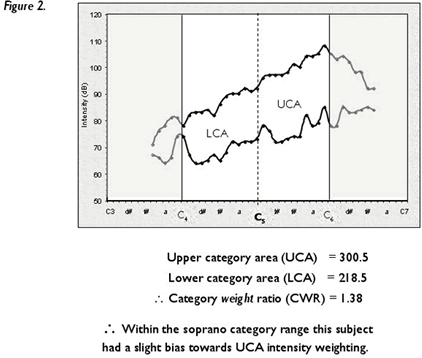An historical, pedagogical and scientific review of an ancient concept in singing.Objective Measures of Craft and Potential in Developing Singers
Martin L. Spencer, M.A. CCC-SLP & L. Arick Forrest, M.D.
The Ohio State University,
Department of Otolaryngology
Voice Institute
This presentation will present and discuss results obtained from three and four years of successive measurement of undergraduate singers in the Ohio State University, Department of Music. Each subject was tested in fall and spring quarters of their freshman year, and subsequent measures were obtained annually in the spring quarter. Each data collection session yielded samples of both the speaking and singing voice:
1. Speaking voice samples, obtained via reading of the Rainbow passage, were subjected to acoustic Multi-Dimensional Voice Profile analysis (Computer Speech Lab). Of greatest interest has been investigation into potential changes in mean speaking Fo and pitch range.
2. Messa di voce. Each subject was tested for dynamic control and associated spectral presence and perturbation via three messe di voce performed on each of four test pitches. The test pitches sampled low, low-mid, high-mid, and high-pitched phonation.
3. Voice range profiles (VRP) were subjected to gross analysis via pitch-intensity maxima and minima. Additionally, the Voice Category Template and Ratio system (VCTR), a system of VRP analysis developed by the primary author, was utilized to ascertain whether individual pitch and intensity characteristics could yield objective verification of singing voice categorization.
The VCTR system is an interpretive tool which may aid in the quantification of voice category presence and potential through composite analysis of voice volume areas (VVA) which have been filtered through user-defined pitch ranges (VVA is calculated as the sum of intensity differences for individual pitches within a chosen range). The VCTR system divides the gross VVA contained within upper and lower VRP boundary contours into four sub-areas; upper and lower within-category areas, and “free” high and low ranges which lie outside of the main category area (see Figures 1-3 for examples). Subsequently, three volume ratios are composed from sub-area comparisons:
1. Category Area Ratio (CAR): the VVAcategory denotes pitch-intensity presence within a particular voice category. The Category Area Ratio (CAR) is the ratio of VVAcategory to total VVA:
Figure 1.
![]()
2. Category Weight Ratio (CWR): the CWR indicates relative intensity potential within the VVAcategory. The CWR is used for discrimination of within-category VVA allocation, via an upper category area (UCA) and lower category area (LCA). The Category Weight Ratio (CWR) was calculated as the ratio between UCA and LCA:
Figure 2.
![]()
3. Free Area Ratio (FAR): the two outer remaining sub-areas are indicated as the Free High Range (FHR) and Free Low Range (FLR). The Free Area Ratio (FAR) was calculated as the ratio of FHR to FLR.
Figure 3.
![]()
Such analysis may prove to be a useful tool which may aid the quantification of voice category presence and potential in singers.


